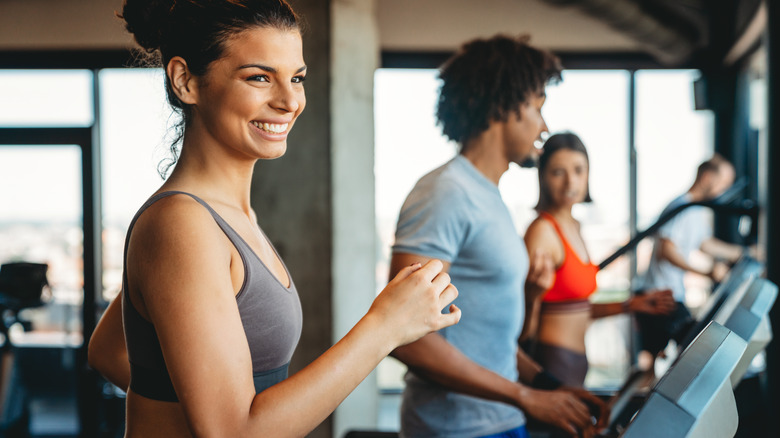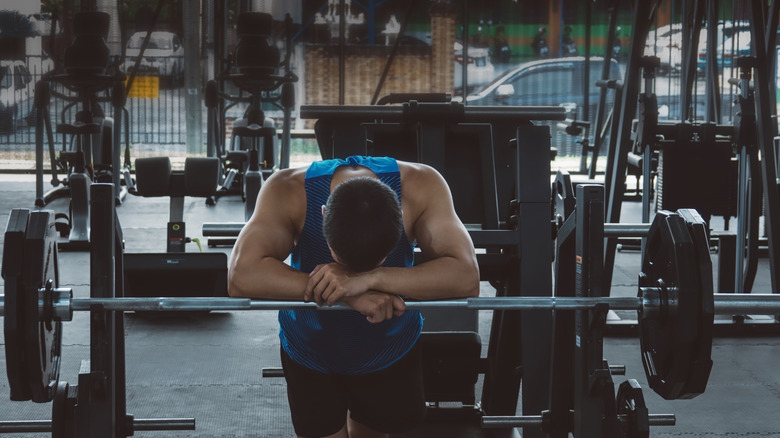What Happens To Your Body When You Go To The Gym Every Day
Remember the old saying, "Less is more?" Not surprisingly, it applies to exercise, too. You may think that going to the gym daily can lead to faster results, but that's not necessarily true. The American College of Sports Medicine recommends at least 30 minutes of moderate-intensity cardiovascular exercise five days a week, or 20 minutes of high-intensity aerobic training three days a week. As far as strength training goes, you should work all the major muscle groups at least twice per week.
These numbers are not set in stone, though. The ideal training frequency depends on your fitness level, health goals, workout intensity and duration, and how much sleep you get. Basketball player Kevin Durant, Jamaican sprinter Usain Bolt, tennis player Michelle Wie, and other pro athletes get eight to 10 or more hours of sleep per night, reports HuffPost. This allows them to recover from training and keep up with the demands of regular exercise. The average person, on the other hand, sleeps less than six hours per night.
Your diet and lifestyle matter as well. If you work long hours and live on takeaway food, you might have a hard time recovering from exercise. With that in mind, let's see what happens to your body when you go to the gym every day.
Daily exercise may improve your health and fitness
Hitting the gym daily can boost your health as long as you don't go overboard. In one study, people who exercised 450 minutes per week had a 37% lower risk of premature death than those with a sedentary lifestyle, reports AARP. That would be around one hour of physical activity per day. Regular exercise has also been linked to lower rates of heart disease, stroke, diabetes, obesity, and cancer, notes the Centers for Disease Control and Prevention (CDC).
Going to the gym every day could improve your overall fitness and conditioning, too. Again, the results depend on what your workout looks like, among other factors. For example, you can combine strength training and cardio to build lean mass and lose fat. Women's Health recommends lifting weights three or four times per week for muscle growth — along with aerobic exercise for general conditioning. However, you might not be able to keep up with the demands of training if you push yourself to the limit during each workout. The more intense your workouts, the more rest you need between sessions.
Last but not least, regular exercise increases bone density and may prevent fractures in the long run, according to the CDC. Both aerobic and resistance training promote bone health and build muscle strength, making everyday activities easier. Moreover, exercise preserves lean mass and can reduce age-related muscle loss. On top of that, it may relieve arthritis pain and lower your risk of injuries.
Going to the gym every day can lead to overtraining
Despite its potential benefits, daily exercise can lead to overtraining, a condition associated with fatigue, muscle soreness, and diminished performance. Marci A. Goolsby, a sports medicine physician at the Hospital for Special Surgery (HSS) explains that if you feel like you're not recovering between sessions, you may be overtraining. If left unaddressed, it can affect your workouts, as well as your sleep, energy levels, and immune system.
According to Camberwell Sports and Spinal Medicine, overtraining is also associated with the so-called female athlete triad, a syndrome characterized by irregular or missing periods, low bone mineral density, decreased muscle strength, mood changes, and other symptoms. In the long run, this condition can increase injury risk and affect sports performance. You may also experience depression, recurring illnesses, and poor recovery.
While there's nothing wrong with daily exercise, you should use common sense when planning your workouts. Some training sessions are more physically demanding than others and require more rest time. If, say, you're training your back or legs on Mondays, take a day off or do a lighter workout on Tuesdays. Alternatively, you can plan an active day and go for a walk or take your bike out for a ride. Yoga, Pilates, and stretching will do the trick, too.



